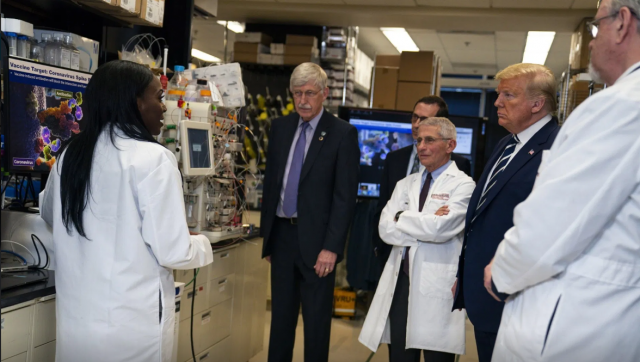Here we take the opportunity to introduce Kizzmedia Shanta Corbett – a star in the fight against Covid 19. She is age 34, and born and bread in America. Her occupation is described as an Immunologist and she works with the National Institutde of Allergy and Infections Diseases. She is known to her friends as Kizzy.
Huge respect is offered to Kizzmedia Corbett – an American viral immunologist at the Vaccine Research Center (VRC) at the National Institute of Allergy and Infectious Diseases, National Institutes of Health (NIAID NIH) based in Bethesda, Maryland.
Appointed to the VRC in 2014, she is currently the scientific lead of the VRC’s Coronavirus Team, with research efforts aimed at propelling novel coronavirus vaccines, including a COVID-19 vaccine.
With black people trending as top news for either being more likely to die from covid19, or experiencing extra poverty through dramatically rising unemployment, how refreshing it is to have a good news story during this pandemic.
Early life
Kizzmedia Corbett was born in Hurdle Mills, North Carolina to Rhonda Brooks. She grew up in Hillsborough, a rural town in North Carolina, where she had a large family of step-siblings and foster siblings.
Corbett went to A.L. Stanback Middle School. In 2004, Corbett graduated from Orange High School in Hillsborough, North Carolina.
In 2008, Corbett received a B.S. in biological sciences and sociology from the University of Maryland, Baltimore County (UMBC), as a student in the Meyerhoff Scholars Program. In 2014, Corbett received a PhD in microbiology and immunology from the University of North Carolina at Chapel Hill.
Career
While in high school, Corbett realized that she wanted to pursue a scientific career, and as part of a program called ProjectSEED, spent her summer holiday working in research laboratories, one of which was at UNC’s Kenan Labs with organic chemist James Morkin. In 2005, she was a summer intern at SUNY StonyBrook in Gloria Viboud’s lab where she studied Yersinia pseudotuberculosis pathogenesis.
From 2006 to 2007, she worked as a lab tech in Susan Dorsey’s lab at the University of Maryland School of Nursing.
After earning her bachelor’s degree, from 2006 to 2009, Corbett was a biological sciences trainer at the National Institutes of Health (NIH), where she worked alongside Dr. Barney Graham. At the NIH, Corbett worked on the pathogenesis of respiratory syncytial virus pathogenesis as well as on a project focused on innovative vaccine platform advancement.
From 2009 to 2014, Corbett studied human antibody responses to dengue virus in Sri Lankan children under the supervision of Aravinda de Silva at University of North Carolina at Chapel Hill. She studied how people produce antibodies in response to dengue fever, and how the genetics of dengue fever impact the severity of a disease. From April to May 2014, as part of her research for her dissertation, Corbett worked as a visiting scholar at Genetech Research Institute in Colombo, Sri Lanka.
In October 2014, Corbett became a research fellow, working as a viral immunologist, at the NIH. Her research aims to uncover mechanisms of viral pathogenesis and host immunity. She specifically focuses on development of novel vaccines for coronaviridae. Her early research considered the development of Severe Acute Respiratory Syndrome (SARS) and Middle East Respiratory Syndrome (MERS) vaccine antigens. During this time, she identified a simple way to make spike proteins that are stabilized in a conformation that renders them more immunogenic and manufacturable, in collaboration with researchers at Scripps Research Institute and Dartmouth College.
At the onset of the 2019–20 coronavirus pandemic, Corbett started working on a vaccine to protect people from coronavirus disease. Recognizing that the virus was similar to severe acute respiratory syndrome coronavirus, Corbett’s team utilized previous knowledge of optimal coronavirus S proteins to tackle the novel coronavirus. S proteins form a “crown” on the surface of coronaviruses and are crucial for engagement of host cell receptors and the initiation of membrane fusion in coronavirus disease. This makes them a particularly vulnerable target for coronavirus prophylactics and therapeutics.
Based on her previous research, Corbett’s team, in collaboration with investigators at UT Austin, transplanted stabilizing mutations from SARS-CoV S protein into SARS-CoV-2 spike protein. She was part of the NIH team who helped solve the cryogenic electron microscopy (CryoEM) structure of the SARS-CoV-2 spike protein. Her prior research suggested that messenger RNA (mRNA) encoding S protein could be used to excite the immune response to produce protective antibodies against coronavirus disease 2019.
To manufacture and test the COVID-19 vaccine Corbett’s team partnered with Moderna, a biotechnology company, to rapidly enter animal studies. Subsequently, the vaccine entered Phase 1 clinical trial only 66 days after the virus sequence was released. The trial, to be completed in at least 45 people, is a dose escalation study in the form of two injections separated by 28 days.
Corbett’s work afforded her the opportunity to be a part of the National Institutes of Health team that welcomed Donald Trump to the Dale and Betty Bumpers Vaccine Research Center in March 2020.
Corbett has called for the public to be cautious and respectful of one another during the coronavirus pandemic, explaining that regular hand washing and sneezing into one’s elbow can help to minimize the spread of the virus. She has also emphasized that we should not stigmatize people who may be from areas where the virus started. When asked about her involvement with the development of the COVID-19 vaccine, Corbett said, “To be living in this moment where I have the opportunity to work on something that has imminent global importance…it’s just a surreal moment for me”.
Alongside her scientific research, Corbett is involved with science communication and public engagement. She regularly shares information on Twitter and takes part in programs to inspire youth in underserved communities.
Source: wikipedia.com










